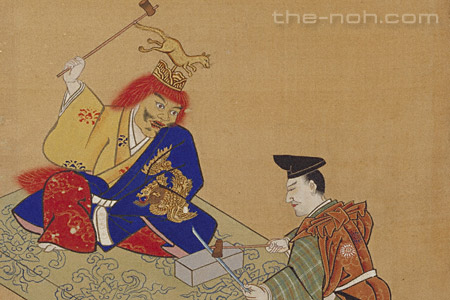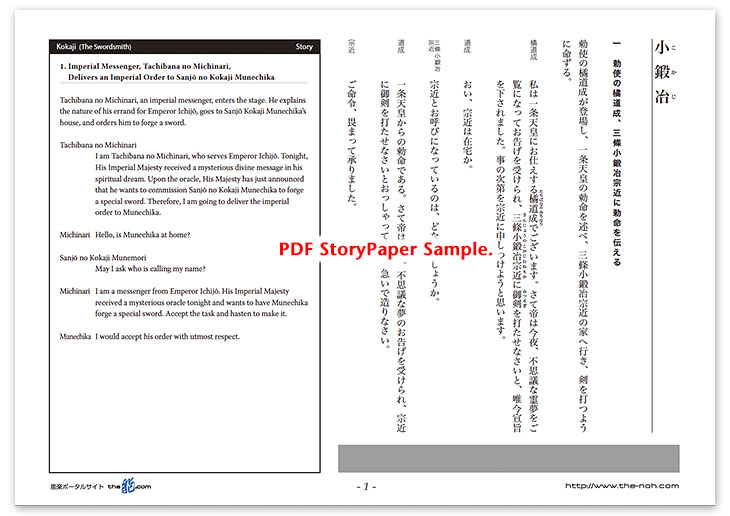
 Kokaji (The Swordsmith)
Kokaji (The Swordsmith)

![]()
At the command of Emperor Ichijo (980-1011), who received an oracle in a dream, Tachibana no Michinari visits and orders Sanjō no Kokaji Munechika, a renowned swordsmith, to forge a sword. Munechika insists that he cannot forge the sword because he does not have a partner swordsmith, who is as skilful as Munechika is. Michinari however refuses to accept his request. Munechika, who is caught between a rock and a hard place, visits Inari Shrine where he prays and requests the assistance of the guardian deity of his clan. At the shrine, a mysterious boy calls to him. The boy encourages Munechika by talking about the dignity of a sword in a Chinese legend and the story of Yamato Takeru-no-mikoto. He promises to become Munechika’s smithing partner and disappears in Mount Inari.
When Munechika goes home, dresses himself for smithing and prays on his platform, there appears before him the deity of Inari who transforms into the spirit of a fox. The deity announces that he will work as the partner of Munechika. The boy who appeared a moment earlier was the transformed Inari deity himself. Munechika, who gained the deity as the smithing partner, successfully forges a sword. Finally, the noted sword ‘Kogitsune-maru’ which is engraved with two names – “Kokaji Munechika” on the face and “Kogitsune (Little Fox)” on the back of the blade as a proof that the deity apprenticed himself to Munechika – is completed. After offering the sword to the imperial messenger, the deity rides on a cloud to return to the peak of Mount Inari.
![]()
“Kokaji” is a popular piece whose story develops quickly, is quite variegated, and includes climaxes in both halves of the drama. The scene where the mysterious boy, who appears in the first half, talks about the spiritual power of great swords, particularly the episode in which Yamato Takeru-no-mikoto who is surrounded by fire slashes grass with his sword Kusanagi to return flames around him and stood down enemies, includes amusing changes of narration and movements. In the latter half, the scenes where the deity becomes the forging partner and Munechika and the deity forge a sword to the climax produce the charms of the piece.
The sharp movements and invigorating chants never allow the audience to become bored. You can straightforwardly enjoy the performers’ smart skills and the power of chorus. Probably due to its highly entertaining nature, the story is transformed into dramas for kabuki and bunraku (Japanese traditional puppet theater) and provides pleasure to a wider variety of audiences.
STORY PAPER : Kokaji (The Swordsmith)
Story Paper presents noh chant stories in modern speech, with story outlines, highlights and more using Adobe PDF format, which can print out and zoom in. Print out the pages and take them with you when you see the actual noh performance.

The copyright of Story Paper is held by the Noh.com. Story Paper is for individual use only. It is prohibited by the copyright law to distribute or publish printed-out Story Paper pages without prior consent. For more information, check the credit and disclaimer pages.



 [Kokaji (The Swordsmith) : Story Paper PDF : 591KB
[Kokaji (The Swordsmith) : Story Paper PDF : 591KB